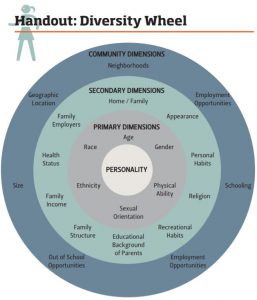I recently the privilege to attend a national training conducted by Washington State University called Navigating Differences. The goal of the program was to help people become culturally competent. No magic pill exists to make us instantly culturally competent. We have to be willing to engage in and grow through the process. According to a policy brief from the National Educator’s Association, “when applied to education, cultural competence centers on the skills and knowledge to effectively serve students from diverse cultures.”
Topic: Diversity
When most people hear or read the word diversity, they automatically think of the race and gender. Some may think of social economic status or religion. The Ohio State University Extension defines diversity as “the differences among people with respect to age, socio-economic status, ethnicity, gender, physical and mental ability, race, sexual orientation, spiritual practices, and other human differences” (https://hr.cfaes.ohio-state.edu/diversity/DR_Sec1_Guide06.pdf), which is also the same definition used by the Washington State Extension’s Navigating Differences curriculum.
The training challenged me in my thinking in many ways. One of my “aha” moments came when it was shared that there are more differences within a cultural group than between groups. Do you question this statement? If so, here is your first challenge: Look up the Diversity Wheel. What is a diversity wheel? It is the dimensions that make us, well, us. You will discover there are somethings that are core to you and permanent – located at the center of the wheel. All other dimensions, which develop over a lifetime, are found on the outer rings of the wheel.
The next phase of your challenge is to look at your group (family, organization, or ethnic group) and examine factors including the following: age, gender, income, physical capacity, health status, beliefs, meal practices, size, height, educational background and hobbies.
These are just a few areas, but you will discover more after you look up a diversity wheel model.
Why should we examine diversity?
Working with people, whether in a personal or professional setting, is complex. The better your understanding of yourself and others is, the more productive your interactions will be. Remember, we are unique and come from different experiences that we bring that to the table with us.
For additional reading, visit the UF/IFAS Electronic Data Information Source:
- Diversity in the Workplace: Benefits, Challenges, and the Required Managerial Tools http://edis.ifas.ufl.edu/hr022
- Building Coalitions: Working with Diverse Cultures http://edis.ifas.ufl.edu/fy508
- Getting Engaged: Program and Event Planning for Clients with Diverse Abilities http://edis.ifas.ufl.edu/wc299
Here are links to a few other Diversity Wheel models:
http://web.jhu.edu/dlc/resources/diversity_wheel/index.html
https://www.ncu.edu/about-ncu/diversity/diversity-wheel#gref
- Art, Garden, and Farm Family Festival - September 27, 2019
- 4-H University is 4 U! - May 6, 2019
- Out of Gas: Helpful Tips for Busy People - March 15, 2019

